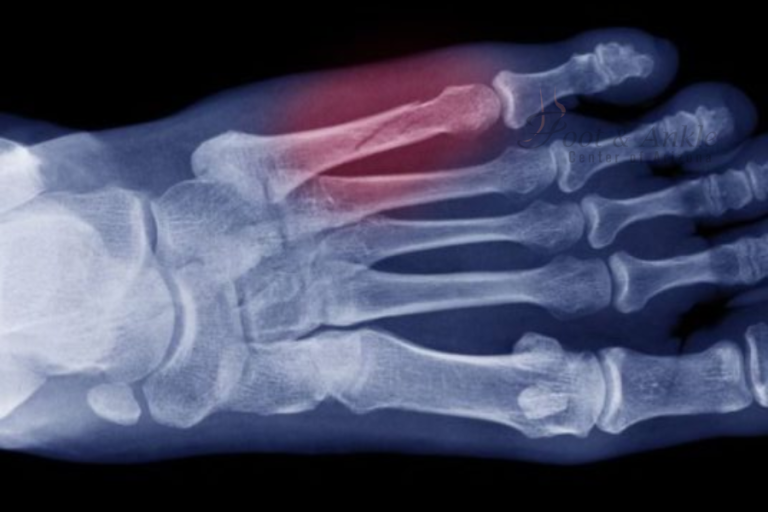A double osteotomy bunionectomy is a surgical procedure done to correct very painful bunions. A bunion is also referred to medically as hallux valgus. It is a condition where the big toe begins to point toward the other toes, ultimately causing a bump on the side of the foot. This may be a source of pain, discomfort, and walking difficulties. After conservative methods of treatment fail to relieve the symptoms—such as orthotics, medication, and rest—surgery may be done.
Understanding a Double Osteotomy Bunionectomy
A double osteotomy bunionectomy involves making two bone cuts, or osteotomies, in repositioning the metatarsal bone to eliminate the deformity. This procedure has a more significant correction than single osteotomy procedures, making it ideal for those patients with significant bunion deformities. There are two chief osteotomies in this operation: distal osteotomy and proximal osteotomy.
Distal Osteotomy
In this, the metatarsal bone is cut near the toe joint, in its distal end, to realign the bone in a more natural position. The cut bone is then secured in its new position by using screws or pins.
Proximal Osteotomy
It is closer to the midfoot (proximal end) about a cut already being made; it corrects further the metaphyseal alignment of the metatarsal. The bone segments are then stabilized using surgical hardware. The surgeon may use these two osteotomies together to more fully correct the bunion and thus improve both the function and appearance of the foot.
Who Needs a Double Osteotomy Bunionectomy?
People who might benefit from a double osteotomy bunionectomy often have severe bunions that have not responded to nonoperative treatments, such as:
- The pain and discomfort are significant enough to interfere with gait or wearing shoes.
- Deformity that interferes with regular daily activities.
- Conservative treatments have not been successful.
- Severe bunion deformities necessitate extensive correction.
The Procedure: What Happens?
Before surgery, a complete examination is performed, including a physical exam and X-rays; other imaging studies may be necessary. This helps the surgeon to plan for surgery and find out the exact form of deformity.
During the Surgery
A double osteotomy bunionectomy is typically performed under regional anesthesia with sedation, although general anesthesia is used in some cases.
- Incision: The surgeon makes an incision along the side of the foot to reach the bunion and metatarsal bone.
- Distal Osteotomy: An incision is made in the metatarsal bone near the toe joint, and the bone is realigned. It is then held in its new position with screws or pins.
- Proximal Osteotomy: A second cut is made closer to the midfoot to realign the bone further. This segment is also fixed in place with surgical hardware.
- Bunionectomy: The bony prominence is shaved down to a much smoother, more natural shape.
- Closure: The incision is closed with sutures, and the foot is dressed with a bandage.
Recovery after Double Osteotomy Bunionectomy
Initial Recovery Phase
- Hospital Stay: Most patients are discharged home the same day; however, some patients may be kept overnight for observation.
- Pain Management: Pain and swelling are managed with medication and ice.
- Mobility: Patients are usually instructed to avoid weight-bearing on the foot for a few weeks. Crutches or a walker can be used to facilitate mobility.
Intermediate Recovery Phase
- Follow-Up Visits: Frequent follow-up visits are required to assess healing progress and remove stitches.
- Physical Therapy: Physical therapy is sometimes prescribed to regain strength and flexibility in the foot and ankle.
- Gradual Weight-Bearing: With progression in healing, gradual weight-bearing is initiated. Special footwear or orthotics may be used to protect the foot.
Long-Term Recovery Phase
- Full Recovery: It may take several months to recover from a bunionectomy fully. Most patients can expect to return to regular activity within six to twelve months after the surgery.
- Bunionectomy Scar: A bunionectomy scar is perfectly normal as part of the healing process following surgery. However, proper wound care and techniques for managing a scar help reduce its appearance. The ultimate aim is to develop feet that are pain-free, functional, and have better cosmesis and alignment.
Comparing Bunionectomy Techniques
Double Osteotomy vs. Chevron Bunionectomy
The chevron bunionectomy, also known as an Austin bunionectomy, involves a V-shaped cut (chevron) to the distal metatarsal bone. This method is ideal for mild to moderate bunions and, in case of severe deformity, may not provide sufficient correction. Bunion deformities, when very severe, require a type of bunionectomy with a more significant correction. This is why the double osteotomy bunionectomy is one of the most effective treatment methods against severely significant bunion deformities.
Double Osteotomy vs. Bunionplasty
Bunionplasty is a type of approach that is cosmetic in nature when performing bunion surgery. The technique is built around minimum scarring with complete aesthetic triumph after surgery. Though substantially great for many, bunionplasty may not produce as good results for severe foot deformities as the double osteotomy bunionectomy would. Patient- Seeking functional correction and aesthetic improvement, could explore consulting the best bunion surgeons near me.
Conclusion
The double osteotomy bunionectomy surgery is a very effective surgery that can be used for correcting severe deformities of the bunion. In this kind of procedure, two different osteotomies are combined and offer an extensive amount of correction possible to enhance the function and appearance of the foot. Though recovery after undergoing bunionectomy surgery can take a couple of months, the long-term reduction in pain and improved mobility make the surgery worth considering for patients with extreme bunions. If you are being bothered by the pain and the deformity of your bunion, then a competent surgeon will help you decide if double osteotomy bunionectomy is the way to go. Do remember to search for the best bunion surgeons near me to get quality care.
For more information and to schedule a consultation, please contact the Foot and Ankle Center of Arizona at +1 480.342.9999. Our teams offer you the best bunion surgery near me, including Bunionplasty and other updated treatments, letting your foot be painless and function normally again.





